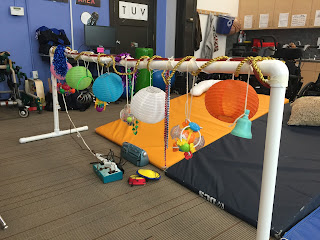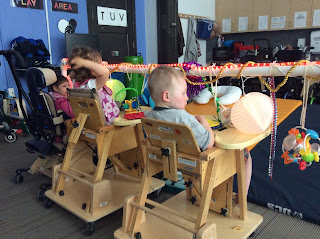Looking for an interactive way to teach career education? Organize a career academy! This was part of my short term program a few months ago (other part was going to a trampoline park--I called it "jump into the career academy"). The idea came to me as a way of teaching about career education to my intermediate through high school grades. This was a hands-on experience that taught about different types of careers. Here are some of the careers we had: massage, cake decorating/baking, catering, culinary, therapy dog trainer and mechanics.
I invited several community partners to be with us. Paul Mitchell (the school) came and ran our beauty/handsome school and taught our students about hygiene, styling your hair and how to look your best. I love how their instructors taught our kids! They had them feel their own hair and how to identify their own hair texture. They brought props to help with teaching braiding and products to learn how to use them. I also invited a chef (we met him when I took my students to do hibachi), a catering manager and massage therapists. I love bringing in community partners because of the mutual learning opportunities it provides. Not only do we learn about them but they learn how to work with people with vision impairments. It's such a win, win!!
There are a few tricks of the trade that I want to share when planning your own career academy.
1. Group students--organize them based on skill and maturity. This way the lesson can go at a good pace for all students. It is difficult for the teachers to teach scattered levels of ability in a short amount of time. I did have students that required a slower or more modified pace. They were in the same group in break out sessions and it helped them not feel rushed.
2. Use related service and community partners as instructors--In culinary school I had our professional chef lead but used my OT students to provide support. The combined knowledge was a great skill set for teaching students skills.
3. Look for careers and not just jobs---There is a difference between a job and a career. The focus was to discuss careers. We discussed the type of training, assistive technology needs and realistic opportunities for people with vision impairments. Did you know that massage is a great opportunity for our kids? We discussed how some things that are recreational could be developed into something more (like becoming a therapy dog trainer).
4. KISS--Keep it simple stupid! The lessons were all designed to fit into a 50 minute window. The cooking recipe needed to be something doable but that also really taught skills at the same time. We made chicken fried rice. We used electric skillets, cooked chicken and incorporated frozen veggies and a rice cooker.
5. Think outside of the box--I invited some mechanics to come and teach our kids about auto mechanics because usually our kids get passed by about learning about this topic. Students learned how to identify all four tires, remove a flat tire (and fix it) and learn about what happens under the hood. Naturally there are things that may be beyond what our kids can do (simply because of the vision required) but we should still "fill them in" so they can have the understanding. I also invited a cake decorator to come and teach our kids how to cake decorate. We brainstormed awesome ways for our kids (including those with no vision) how to make beautiful cakes.
Students learned how to remove and fix a flat tire.
Our cake decorator instructor had the brilliant idea to use cookie cutters to teach design. Students placed the cookie cutter on their cake and used it to follow the "pattern".
We learned all about massage and the different types of massage that can be offered.
The day went by fast and crazy but all students had a great time. We were able to have a follow up Q&A with all our instructors and students were able to take home projects and tip sheets.
Can you identify all the nine areas of the ECC that we covered today? We hit on all of them in a meaningful way.
My follow up activity will be taking the students off campus to the actual locations. We have been fortunate enough to have our community partners stay on as mentors. Our catering manager has volunteered to be our catering mentor for our campus transition students that are now running their own catering business. Our mentor gives our students feedback and training. This is valuable because it develops their skill set and even provides an opportunity for some to apply to work at a Paradise Bakery or Panera in their catering department. I'll write up our part two as soon as we have it!
























